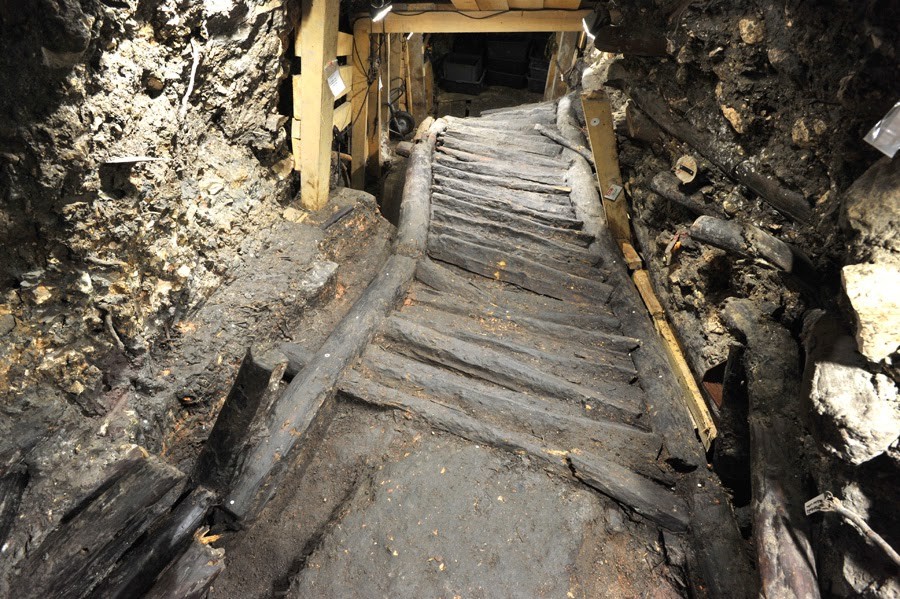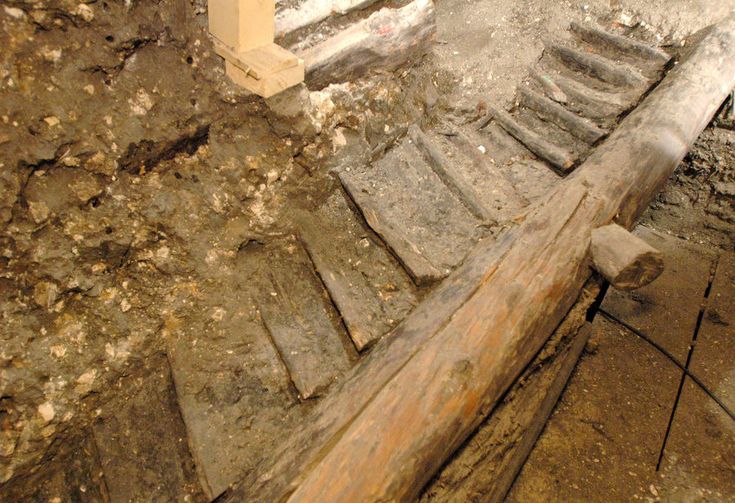Hallstatt’s Timeless Treasure: How a 3,400-Year-Old Wooden Staircase Sheds Light on the Past

The ancient world is full of wonders that continue to captivate and inspire us today. One such marvel is the oldest wooden staircase ever discovered, located in the Hallstatt salt mine in Austria. This extraordinary structure, dating back over 3,400 years, offers a glimpse into the ingenuity and craftsmanship of our ancestors.
The Discovery of the Ancient Staircase
In 2002, the remarkable wooden staircase was unearthed in the prehistoric section of the Christian von Tuschwerk salt mine in the picturesque town of Hallstatt. Investigations, including tree-ring dating, conducted by scientists from the Natural History Museum of Vienna revealed that the stairs were used to transport “white gold” – salt – out of the mountain during the years 1343-1344 BCE.

Unique Construction and Preservation
The staircase is truly one-of-a-kind, both in its construction and its remarkable state of preservation. No similar example has been found from either earlier or more recent times. The design had to meet specific requirements, such as portability, adjustability, and replaceability, to function effectively within the salt mine environment.
The steps are an impressive 1.2 meters (4 feet) wide, allowing for the transport of heavy loads while also enabling personnel access and a two-way circulation system with carry sacks. The woodworking techniques used, including transverse cutting with a bronze axe, are equally fascinating.
Evidence of Bronze Age Salt Mining

The Hallstatt salt mine has yielded numerous artifacts that shed light on the mining practices of the Bronze Age. The discovery of parts of similar staircases in other areas of the mine suggests that these structures were the access equipment of choice for salt extraction during this period.
Researchers believe there were likely two variants of the staircase: a wide construction supported on mining waste, primarily used for salt transport, and a narrower version within the shafts, designed for personnel access.
Preservation and Challenges

The salty environment of the Hallstatt salt mine is credited with the exceptional preservation of the wooden staircase, as well as other artifacts found in the site. However, this preservation has also presented its own challenges.
When the staircase was disassembled and brought to the Museum of Natural History in Vienna for analysis in 2014, fungi immediately began to grow on the wood, despite efforts to preserve it. As a result, the staircase was returned to Hallstatt in 2015 and is now on display within the “show-mine” to ensure its long-term survival.
The discovery of the oldest wooden staircase in Europe, dating back to over 3,400 years ago, is a testament to the ingenuity and craftsmanship of our ancestors. This remarkable structure, preserved in the Hallstatt salt mine, offers a unique glimpse into the Bronze Age and the remarkable engineering feats of the past. As we continue to explore and uncover the secrets of our shared history, the Hallstatt staircase stands as a testament to the enduring spirit of human innovation and the timeless wonders that still await us.
Video
News
The Hanging Temple: China’s 1,500-Year-Old Cliffside Marvel of Faith and Engineering
The Hanging Temple: China’s 1,500-Year-Old Cliffside Marvel of Faith and Engineering Perched precariously on the cliffs of Mount Heng in Shanxi Province, China, the Hanging Temple, also known as Xuankong Temple, Hengshan Hanging Temple, or Hanging Monastery, is an architectural…
The Willendorf Venus: A 30,000-Year-Old Masterpiece Reveals Astonishing Secrets
The Willendorf Venus: A 30,000-Year-Old Masterpiece Reveals Astonishing Secrets The “Willendorf Venus” stands as one of the most revered archaeological treasures from the Upper Paleolithic era. Discovered in 1908 by scientist Johann Veran near Willendorf, Austria, this small yet profound…
Unveiling the Maya: Hallucinogens and Rituals Beneath the Yucatán Ball Courts
Unveiling the Maya: Hallucinogens and Rituals Beneath the Yucatán Ball Courts New archaeological research has uncovered intriguing insights into the ritual practices of the ancient Maya civilization. The focus of this study is a ceremonial offering found beneath the sediment…
Uncovering the Oldest Agricultural Machine: The Threshing Sledge’s Neolithic Origins
Uncovering the Oldest Agricultural Machine: The Threshing Sledge’s Neolithic Origins The history of agricultural innovation is a fascinating journey that spans thousands of years, and one of the earliest known agricultural machines is the threshing sledge. Recently, a groundbreaking study…
Nara’s Ancient Sword: A 1,600-Year-Old Protector Against Evil Spirits
Nara’s Ancient Sword: A 1,600-Year-Old Protector Against Evil Spirits In a remarkable discovery that has captured the attention of archaeologists and historians alike, a 7.5-foot-long iron sword was unearthed from a 1,600-year-old burial mound in Nara, Japan. This oversized weapon,…
The Inflatable Plane, Dropped Behind the Lines for Downed Pilots
Experimental The Inflatable Plane, Dropped Behind the Lines for Downed Pilots The Inflatoplane from Goodyear was an unconventional aircraft developed by the Goodyear Aircraft Company, a branch of the renowned Goodyear Tire and Rubber Company, also famed for the Goodyear…
End of content
No more pages to load











